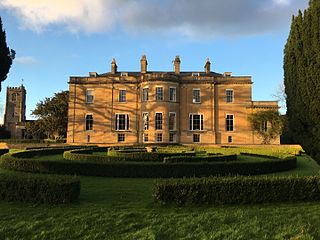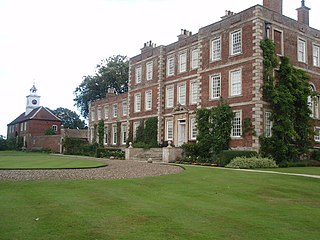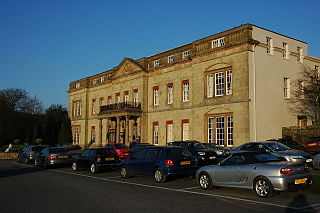
Bretton Hall is a country house in West Bretton near Wakefield, West Yorkshire, England. It housed Bretton Hall College from 1949 until 2001 and was a campus of the University of Leeds (2001–2007). It is a Grade II* listed building.

Lyme Park is a large estate located south of Disley, Cheshire. The estate is managed by the National Trust and consists of a mansion house surrounded by formal gardens, in a deer park in the Peak District National Park. The house is the largest in Cheshire, and is recorded in the National Heritage List for England as a designated Grade I listed building.

Elsham Hall is a 17th century country house situated in its own parkland in Elsham, North Lincolnshire, England.

Brocklesby is a village and civil parish in the West Lindsey district of Lincolnshire, England. It is situated 1 mile (1.6 km) south from Habrough, 4 miles (6.4 km) south-west from Immingham, and is located close to the border of both North Lincolnshire and North East Lincolnshire and is the most northerly village within non-metropolitan Lincolnshire and is also near Humberside International Airport.

Dinder House, is a Somerset estate with a small country house Grade II Regency listed building in the village of Dinder, in the civil parish of St Cuthbert Out in Somerset. Dinder House was formerly a manor house dating back to the 12th century, but the existing building was constructed between 1799 and 1801 by the Rev William Somerville on the original site. The estate remained as the seat of the Somerville family until the late twentieth century.

Bramham Park is a Grade I listed 18th-century country house in Bramham, between Leeds and Wetherby, in West Yorkshire, England.

Gunby Hall is a country house in Gunby, near Spilsby, in Lincolnshire, England, reached by a half mile long private drive. The Estate comprises the 42-room Gunby Hall, listed Grade I, a clocktower, listed Grade II* and a carriage house and stable block which are listed Grade II. In 1944 the trustees of the Gunby Hall Estate, Lady Montgomery-Massingberd, Major Norman Leith-Hay-Clarke and Field Marshal Sir Archibald Montgomery-Massingberd, gave the house to the National Trust together with its contents and some 1,500 acres of land.

Birtles Hall is a country house in the parish of Over Alderley, Cheshire, England. It was built in about 1819 for Robert Hibbert. The interior of the house was badly damaged by fire in 1938, and it was reconstructed by the Arts and Crafts architect James Henry Sellers. The exterior is constructed in buff ashlar sandstone. The roofs are of Welsh slate, and there are three brick chimneys. The house is in two storeys, with a south front of five bays. Along the top of the south front is a plain frieze and a cornice supporting a balustrade. Protruding from the central bay of the lower storey is a porch with Ionic columns and a balustrade. Figueirdo and Treuherz describe the style as "severe Neoclassical". The house is recorded in the National Heritage List for England as a designated Grade II listed building. Also listed Grade II are terrace walls in front of the house, and the stable block.
Butley Hall is a former large house, now converted into flats, in the village of Prestbury, Cheshire. It was rebuilt in 1777 for Peter Downes. The house was extended by an addition to the north in the 19th century, and converted into flats during the 20th century. It is constructed in sandstone rubble with ashlar dressings, it has Kerridge stone-slate roofs, and five brick chimneys. The main front of the house is in two storeys and seven bays. The central three bays protrude forwards and are surmounted by a triangular pediment. On each side of the front are wings with Venetian windows. To the rear of the house is the front of an earlier three-storeyed house dating from the 17th century. The house is recorded in the National Heritage List for England as a designated Grade II listed building.

Hankelow Hall is a former country house to the north of the village of Hankelow, Cheshire, England.
Langley Hall is a country house in the village of Langley, Cheshire, England. It was built in about 1650, and is described by the authors of the Buildings of England series as "a distinguished house". The house is constructed in coursed rubble with ashlar dressings, and is roofed in stone slate. It has two storeys and an attic. The entrance front is symmetrical with seven bays and a central doorway. Above the doorway is a cartouche containing a carved face. It is inscribed MAC 1696. The house is recorded in the National Heritage List for England as a designated Grade II* listed building. It has been converted into three flats.
Norley Hall is a country house in the village of Norley, Cheshire, England. It was built in about 1500 on the site of an earlier house for the Hall family, enlarged in 1697 for John Hall, rebuilt in 1782 for William Hall, and enlarged again in about 1845 for Samuel Woodhouse, giving it a Tudor appearance. The architect responsible for this latest enlargement was Alfred Bowyer Clayton. The service wing was extended later in the 19th century, and further additions and alterations were carried out during the 20th century, including the division of the building into two houses. The gardens were designed by Edward Kemp. The house is rendered, and has a sandstone ashlar basement, porch and dressings. The roofs are slated. Its plan is irregular. The main block is in two storeys, plus an attic and a basement. On the entrance front is a projecting central gabled bay. There is a single-storey porch with buttresses, pinnacles, a pierced balustrade, and a Tudor arched doorway. On the left side of the house is an octagonal stair turret surmounted by a bellcote with a conical roof. The service wing also has two storeys. The house is recorded in the National Heritage List for England as a designated Grade II listed building.

Ramsdell Hall is a country house in the parish of Odd Rode in Cheshire, England, overlooking the Macclesfield Canal. It was built in two phases during the 18th century, and is still in private ownership.

Shrigley Hall is a former country house standing to the northwest of the village of Pott Shrigley, Cheshire, England. It has since been used as a school, when a chapel was added, and later as a hotel and country club operated by The Hotel Collection.

Willington Hall is a former country house in the parish of Willington, Cheshire, England. It was extended in 1878, but reduced in size in the 1950s, and has since been in use as a hotel.

Saltmarshe Hall is a grade II* listed 19th-century country house in Saltmarshe, East Riding of Yorkshire, England, on the north bank of the River Ouse across from Goole. It stands in 17 acres of gardens.

Moseley Hall is a Grade II listed 18th-century country house which was situated in parkland in Moseley, Birmingham. The hall itself is now part of Moseley Hall Hospital and much of the surrounding estate has been developed for roads and housing.

Heathcote is a Neoclassical style villa in Ilkley, West Yorkshire, England. Designed by architect Edwin Lutyens, it was his first comprehensive use of that style, making it the precursor of his later public buildings in Edwardian Baroque style and those of New Delhi. It was completed in 1908.

Bispham Hall is a Grade II* listed Elizabethan country house in Billinge, now part of the Metropolitan Borough of Wigan, Greater Manchester.

Merton Hall is a 19th century country house in Merton, Norfolk, England. The extant north-west wing is a Grade II listed building The 17th-century gatehouse, the 19th century stables and other associated buildings are also listed. The house stands in a park about 2 miles in length.






















